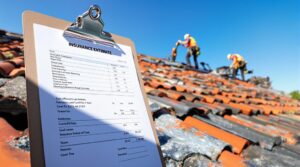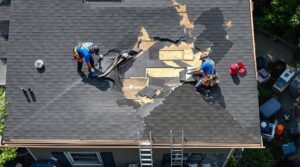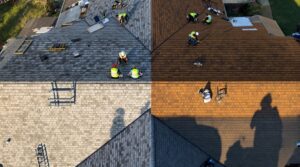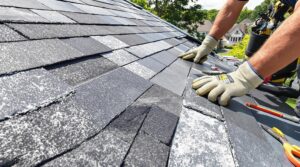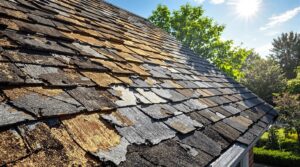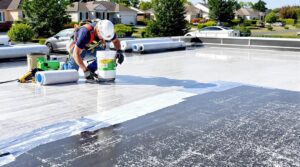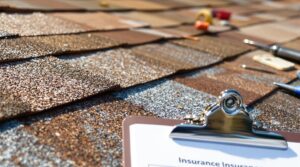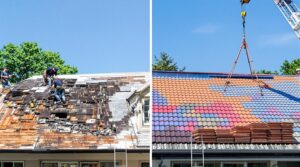Is your built-up roof showing signs of wear? Let's dive into what you need to know about BUR repairs – it's like giving your roof a protective suit of armor!
Think of built-up roofing as a layered sandwich, where each layer plays a crucial role in keeping your home dry and protected. From the tried-and-true Three-Course Method to modern solutions like silicone coatings and spray foam applications, you've got options to tackle those pesky leaks and damages.
When it comes to your wallet, BUR repairs typically run between $2-$7 per square foot. Got a small patch that needs fixing? You might spend around $150. Dealing with major damage? Be prepared to invest upwards of $7,000 for a comprehensive reconstruction.
Here's the good news about your home insurance: it's got your back when Mother Nature throws a tantrum! Wind damage, hail strikes, and similar sudden events are usually covered. But remember, regular wear and tear is on you. Want to maximize your insurance claim? Consider working with a public adjuster – they're like professional negotiators who can dramatically boost your settlement and help you navigate the complex world of insurance coverage.
Think of your built-up roof as an investment in your home's future – taking care of it today means fewer headaches tomorrow!
Key Takeaways
Want to know the ins and outs of Built-Up Roof (BUR) repairs? Let's break it down!
Your BUR's health depends on choosing the right repair method. Think of it like treating a patient – you've got options like the tried-and-true Three-Course Method, sleek silicone coatings, or high-tech spray foam solutions. Each tackles different roofing ailments, from minor leaks to major structural concerns.
When it comes to your wallet, BUR repairs can range from a quick fix to a significant investment. Minor patches might set you back $150-$1,000 (about the cost of a new smartphone), while those bigger headaches could climb to $3,000-$6,000. Per square foot? You're looking at $2-$7 – less than a fancy coffee!
Here's the good news: your home insurance likely has your back when Mother Nature throws a tantrum. Fire, wind, hail, and lightning damage? Covered! But just like your car's warranty won't cover regular oil changes, don't expect insurance to pick up the tab for normal aging and wear.
Pro tip: bring in a public adjuster – they're like your personal roof repair negotiator. They can boost your insurance settlement by 20-50%, turning a basic claim into a comprehensive coverage package.
Think of your BUR like a trusty vehicle – regular check-ups and detailed maintenance records aren't just paperwork, they're your ticket to a longer-lasting roof and smoother insurance claims. Keep those inspection reports as clean as your roof should be!
Understanding Built-Up Roof Systems and Common Issues
Built-up roofing (BUR) systems represent one of the most durable and time-tested commercial roofing solutions, consisting of multiple layers of bitumen and reinforcing ply sheets that work together to create a waterproof barrier.
These systems typically include a base sheet for initial protection, followed by alternating layers of asphalt or coal tar and reinforcing fabrics.
Despite their durability, BUR systems can develop issues that require attention through proper roof maintenance.
Common problems include leakage from improper installation techniques, surface deterioration of the protective aggregate layer, and alligator cracking caused by prolonged exposure to heat.
Ponding water presents another significant concern, potentially compromising the roof's structural integrity.
Regular inspections can identify these issues early, preventing more extensive damage and maintaining the system's expected 20-plus-year lifespan.
Popular BUR Repair Methods and Their Applications
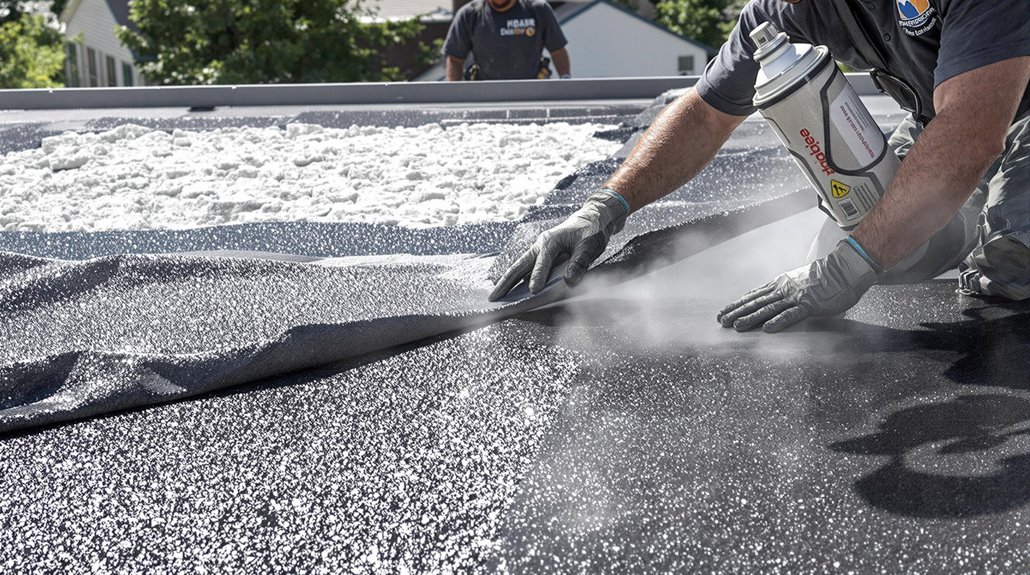
The Three-Course Method stands as a foundational BUR repair technique, offering reliable results through its systematic application of asphalt and fabric layers.
Silicone coating systems provide an effective solution for smooth built-up roofs, extending service life while creating a waterproof barrier.
Spray foam applications deliver dual benefits of enhanced insulation and leak prevention, particularly effective for built-up roofs with loose aggregate surfaces.
Three-Course Method Benefits
While numerous repair methods exist for built-up roofing systems, the three-course method stands out for its extensive approach to waterproofing and structural reinforcement. Its three-layer application delivers superior repair longevity through systematic material layering and precise installation techniques. The three course efficiency is evident in its thorough sealing capabilities and adaptability to various roofing conditions. With proper installation, repairs made using this method can help maximize the 40-75 year lifespan typical of quality roofing systems.
| Benefit Category | Primary Advantage | Long-Term Impact |
|---|---|---|
| Durability | Enhanced structural integrity | Reduced maintenance needs |
| Waterproofing | Complete seal formation | Prevention of water damage |
| Cost-Effectiveness | Higher initial investment | Decreased repair frequency |
| Versatility | Multiple application scenarios | Adaptable solutions |
| Risk Management | Improved leak protection | Lower insurance claims |
This method particularly excels in addressing complex issues like alligatoring while providing a sustainable solution for gravel retention problems.
Silicone Coating Advantages
Silicone coatings represent a significant advancement in BUR repair technology, offering superior durability and cost-effective solutions for aging roof systems. Among the primary silicone benefits are exceptional water resistance, UV protection, and the ability to withstand extreme temperature fluctuations without degradation.
Application techniques are straightforward, requiring minimal preparation and no fabric reinforcement, making installation efficient and cost-effective. The coating forms a seamless, watertight membrane that effectively prevents leaks and manages ponding water.
Additionally, silicone coatings contribute to environmental sustainability through low VOC emissions and elimination of roof tear-off waste. These coatings also enhance energy efficiency by reflecting sunlight and reducing roof surface temperatures, leading to decreased cooling costs.
However, contractors must note that silicone coatings are incompatible with coal tar pitch substrates.
Professional installation by certified contractors is essential since DIY repair mistakes are typically not covered by standard homeowners insurance policies.
Spray Foam Applications
Many commercial and residential contractors rely on spray foam applications as a robust solution for BUR repairs, utilizing its unique two-component composition that creates an impermeable, seamless barrier when applied.
The system's ability to conform to irregular surfaces and fill existing gaps makes it particularly effective for addressing deteriorating built-up roofs.
Among the notable spray foam benefits are its superior insulation properties and capacity to create custom drainage slopes.
Professional contractors apply the foam in ideal weather conditions, followed by a protective elastomeric coating that guarantees UV resistance.
With proper installation, spray foam longevity can extend up to 20 years, and the system can be renewed with additional coatings.
While initial costs range from $5-$10 per square foot, the long-term energy savings and minimal maintenance requirements often justify the investment.
Weather impact assessments by insurance adjusters can significantly affect how quickly spray foam repair claims are processed and approved.
Cost Breakdown for Different BUR Repair Options
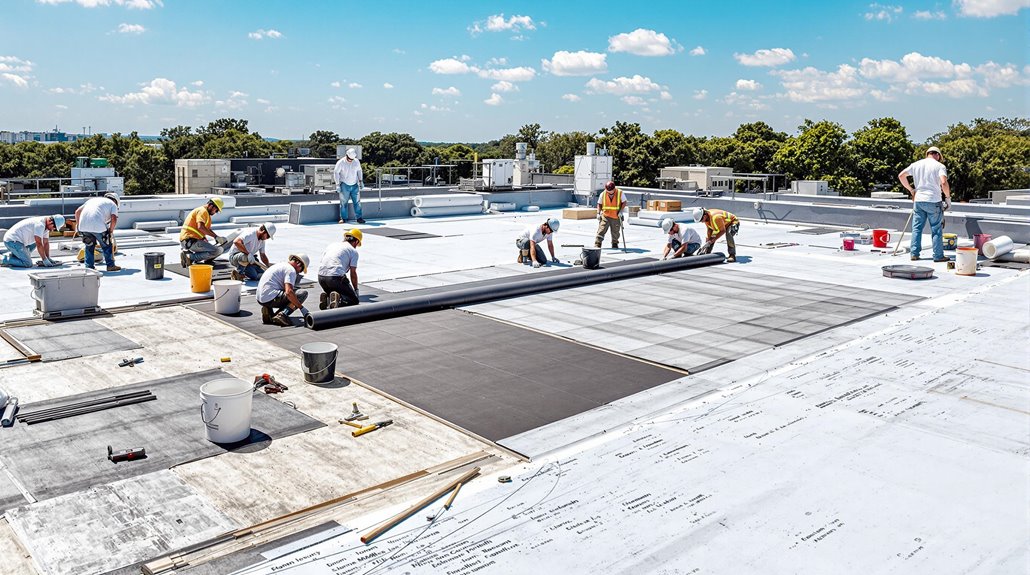
Understanding the cost breakdown for Built-Up Roof (BUR) repair options requires careful consideration of project scope and damage severity.
Repair techniques range from minor fixes to major structural repairs, with costs varying considerably based on material selection and labor requirements. A thorough cost comparison reveals that minor repairs typically range from $150-$1,000, while extensive damage may necessitate investments of $3,000-$6,000 or more.
- Basic flashing repairs and drain maintenance: $200-$500
- Membrane layer replacement: Variable based on square footage
- Insulation upgrades: $100-$450 per 100 square feet
- Emergency repair premium: Additional $200-$300
Factors affecting total repair costs include geographical location, roof age, existing damage patterns, and local labor rates.
Insurance coverage and preventative maintenance strategies can greatly impact long-term expenditures for BUR systems.
Working with public adjusters on complex repairs can increase insurance claim settlements by 20-50% while ensuring proper coverage for all damage.
How Home Insurance Policies Cover BUR Repairs
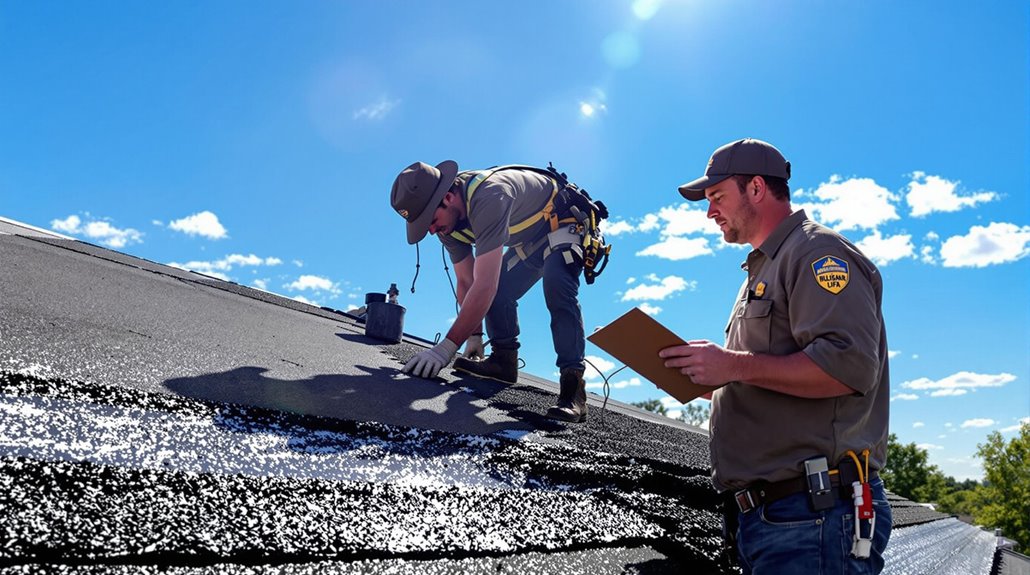
Home insurance coverage for Built-Up Roof (BUR) repairs varies considerably based on policy terms, perils covered, and the roof's condition. Insurance policies typically cover damage from fire, wind, hail, vandalism, and lightning strikes.
However, normal wear and tear, lack of maintenance, and age-related deterioration are usually excluded from coverage.
The claim process often requires documentation of the damage cause and a professional assessment. Roofs over 20 years old may only receive partial coverage or require additional inspections.
Filing a BUR insurance claim requires thorough documentation and inspections, with aging roofs facing potential coverage limitations.
Insurers generally consider the roofing material's durability and fire resistance when determining coverage terms. Installing high-quality BUR materials that meet local building codes can lead to more favorable insurance terms and potentially lower premiums.
Policyholders must meet their deductible before coverage applies to repair costs.
Working with public adjusters can increase claim payouts by 20-50% for covered BUR repairs.
Weather Impact and Durability Considerations
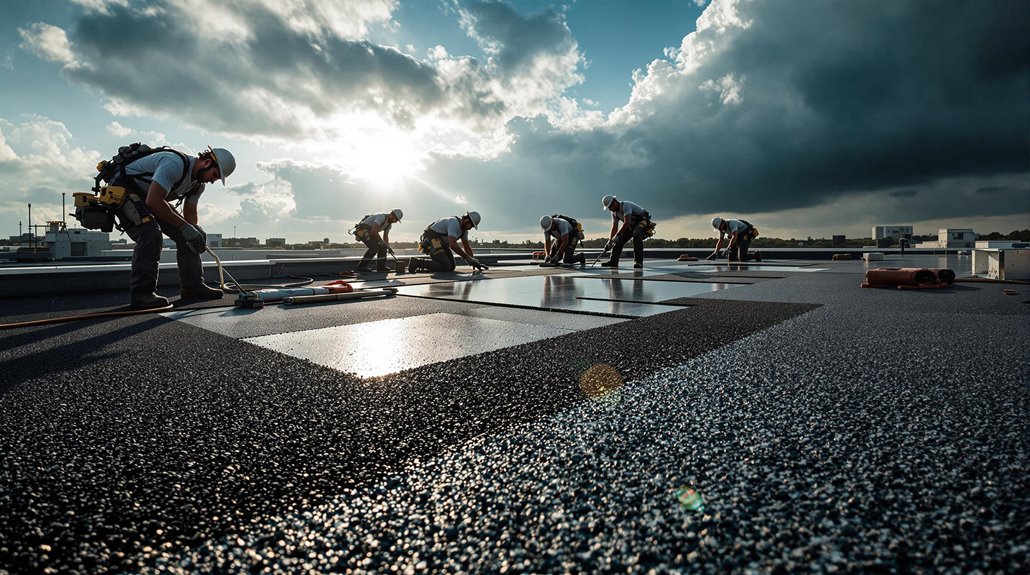
Weather patterns greatly influence the structural integrity and longevity of built-up roofing (BUR) systems through cycles of UV exposure, temperature fluctuations, and moisture penetration.
Implementing proper storm protection methods, including adequate drainage systems, wind-resistant flashings, and reflective coatings, helps mitigate potential damage from severe weather events.
Regular monitoring of weather-related wear patterns enables facility managers to develop targeted maintenance strategies that enhance the roof's resilience against specific regional climate challenges.
Weather Pattern Effects
While built-up roofs (BURs) demonstrate remarkable resilience against various climate conditions, their long-term durability depends considerably on regional weather patterns and proper maintenance protocols.
The weather resilience of BUR systems is particularly evident in their ability to withstand extreme temperature fluctuations and UV exposure, thanks to their protective gravel layer.
However, maintenance strategies must adapt to specific regional challenges, especially in areas prone to severe weather conditions.
- Areas with high UV exposure require regular inspection of the gravel layer to maintain UV protection
- Regions with heavy rainfall need enhanced drainage systems and frequent moisture checks
- High-wind zones demand additional securing measures for the gravel top layer
- Humid climates necessitate proper ventilation systems to prevent moisture accumulation beneath layers
Storm Protection Methods
Protecting built-up roofs against severe storm damage requires implementing multiple defense strategies that work in concert. Critical components include proper deck preparation, secure fastening systems, and strategic material selection focused on durability and wind resistance.
To enhance roof resilience, installations should incorporate reinforced edges with anti-bridging bars, robust flashing systems, and properly secured overhangs. Regular inspections help identify vulnerabilities before storms strike, while proper insulation and ventilation systems prevent moisture accumulation and thermal stress.
The integration of impact-resistant materials, coupled with efficient drainage solutions and gutter systems, provides thorough protection against water damage and high winds. Additionally, maintaining continuous load paths from roof to foundation ensures structural integrity during severe weather events.
Modern Solutions and Long-Term Maintenance Strategies
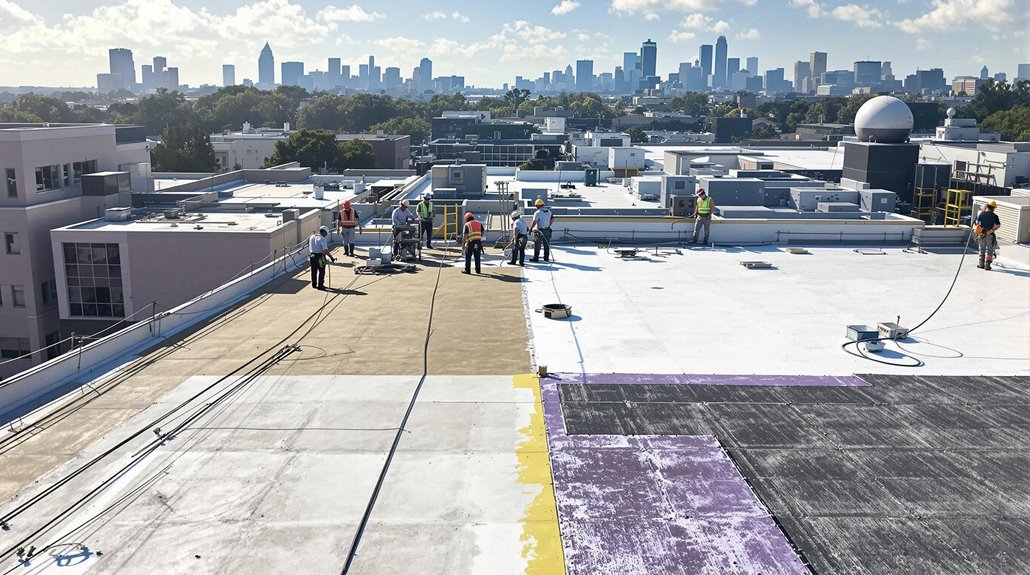
Modern built-up roofing (BUR) systems have evolved greatly, incorporating advanced materials and installation techniques that enhance durability and performance.
Recent roofing innovations include spray foam systems that provide seamless membranes and superior insulation, while silicone coating systems offer cost-effective repairs for smooth BURs. These solutions, combined with proper maintenance tips, greatly extend roof longevity.
- Regular inspections and documentation of maintenance activities support insurance coverage and facilitate early problem detection.
- Prompt repairs of leaks and defects prevent escalation into costly structural issues.
- Modern spray foam solutions deliver enhanced energy efficiency with R-values of 6.5 per inch.
- Installation of new systems can improve building value and secure better insurance terms through documented maintenance records.
The Benefits Of Consulting A Public Adjuster For Roof Repairs
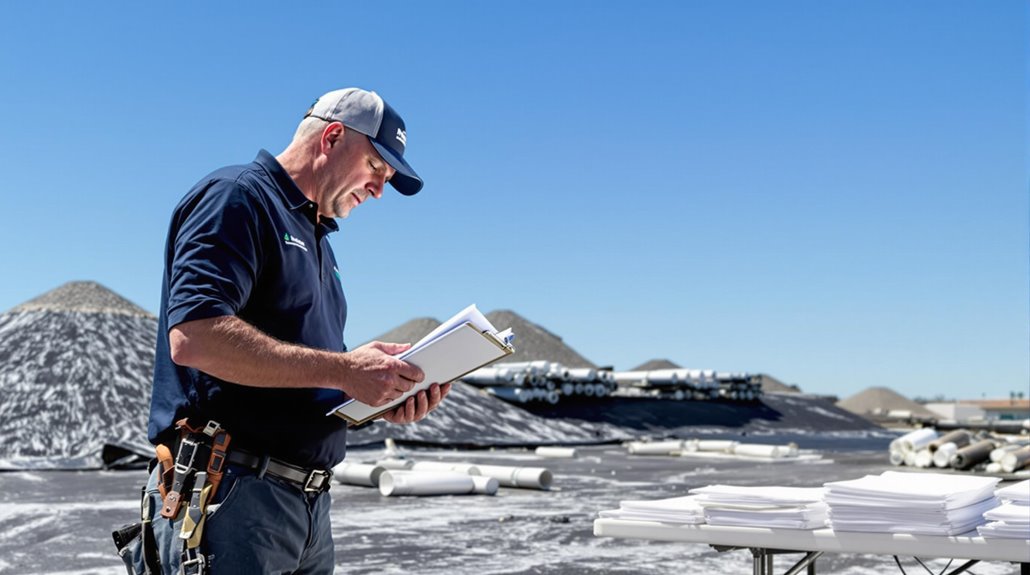
Public adjusters bring specialized expertise in maneuvering complex insurance claims for BUR roof repairs, providing objective damage assessments that guarantee all deterioration is properly documented and valued.
Their professional representation streamlines the claims process through efficient documentation, evidence collection, and strategic negotiations with insurance carriers.
Statistical evidence suggests that policyholders who engage public adjusters often secure considerably higher claim settlements compared to those who handle claims independently, making their services particularly valuable for extensive BUR roof damage scenarios.
Expertise In Insurance Claims
Insurance complexities often make roof damage claims challenging for property owners to navigate alone. Public adjuster benefits include expert policy interpretation, thorough damage documentation, and skilled negotiation strategies that frequently result in higher settlements. Their insurance claim expertise enables detailed evaluation of roof damage while ensuring all potential coverage areas are properly addressed.
- Professional documentation management, including detailed photographs and damage reports, strengthening the claim's validity
- Accurate interpretation of insurance policy terms and conditions, preventing coverage oversights
- Strategic negotiation with insurance companies, leading to maximized settlement outcomes
- Efficient claim processing through established procedures and industry knowledge, reducing delays
These professionals serve as dedicated advocates throughout the claims process, managing complex interactions with insurance providers while alleviating stress for property owners.
Objective Damage Assessment
When evaluating roof damage, professional adjusters employ systematic protocols to deliver unbiased evaluations that property owners can rely upon.
Their damage evaluation process includes thorough roof inspections, material condition analysis, and structural integrity assessments to identify both visible and concealed issues.
These specialists utilize specialized software and weather data analysis to correlate damage with specific events, ensuring accurate documentation for insurance claims.
Their all-encompassing approach encompasses detailed report writing, visual evidence collection, and precise cost calculations that consider regional variations and code requirements.
This methodical assessment forms the foundation for developing effective repair strategies while preventing overestimation of costs.
The process also identifies potential future problems, helping property owners make informed decisions about necessary repairs while maintaining compliance with local building regulations.
Streamlined Claim Process
Steering through the complexities of roof damage claims becomes notably more manageable with the assistance of a public adjuster. These professionals streamline the process by providing expert guidance in claims documentation and implementing effective negotiation strategies with insurance companies. Their extensive understanding of insurance policies and regulations guarantees accurate interpretation and maximum claim potential.
- Thorough damage assessment and detailed documentation collection
- Professional policy interpretation and compliance verification
- Strategic negotiation with insurance carriers for ideal settlements
- Expedited processing through systematic claim management
Public adjusters minimize common pitfalls in the claims process while maintaining clear communication channels between all parties. Their expertise in handling complex claims and thorough understanding of insurance terminology greatly reduces processing time and improves the likelihood of favorable settlement outcomes for property owners.
Higher Claim Payouts & Settlements
Securing ideal claim settlements for roof repairs frequently hinges on the expertise of public adjusters. Statistical evidence demonstrates their ability to increase settlement amounts by up to 747% compared to unassisted claims, considerably reducing out-of-pocket expenses for property owners.
Public adjusters employ sophisticated claim negotiation techniques, leveraging their thorough understanding of insurance policies and roofing systems. Their settlement strategies include thorough damage documentation, precise cost assessments, and expert policy interpretation.
Working on a contingency basis, these professionals collaborate with roofing specialists to identify all compensable damages, from minor repairs costing $150-$400 to major reconstructions exceeding $7,000. Through meticulous documentation and strategic negotiations, public adjusters consistently maximize claim payouts while ensuring adherence to policy terms and conditions.
About The Public Claims Adjusters Network (PCAN)
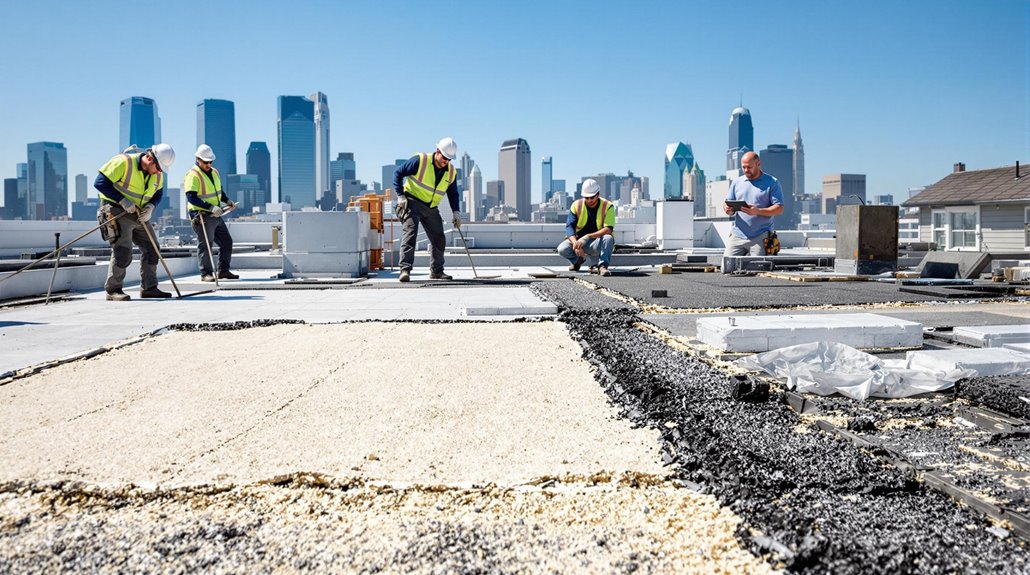
Although specific information about PCAN is limited, claims adjusters play an essential role in managing property insurance claims for roof damage assessments.
Public adjusters utilize residential roof reports to streamline the claims management process, guaranteeing accurate measurements and fair settlements for policyholders. These professionals evaluate damages, validate claims, and determine appropriate repair or replacement costs for built-up roofs using detailed documentation and site inspections.
- Adjusters rely on extensive roof reports containing measurements, diagrams, and photographs.
- Documentation helps expedite claims by providing essential data before site visits.
- Professional assessments guarantee accurate cost calculations ranging from $2-$7 per square foot for repairs.
- Proper evaluation helps prevent supplemental claims and supports fair settlements for policyholders.
Frequently Asked Questions
Can I Perform Emergency BUR Repairs During Rainy Weather?
Like maneuvering through treacherous waters, performing emergency repairs during rainy conditions poses significant safety risks. Professional contractors should only attempt critical temporary fixes using proper tarping and safety protocols.
How Often Should I Schedule Professional Inspections for My Built-Up Roof?
Professional inspection frequency should include bi-annual visits, plus additional assessments following severe weather events. Maintenance tips recommend scheduling spring and fall inspections for ideal preventive care.
Will Installing Solar Panels Damage My Built-Up Roofing System?
Professional solar panel installation, when properly executed with appropriate mounting systems and load distribution, should not damage roof integrity if the structure meets weight-bearing requirements and waterproofing standards.
Are Built-Up Roofs Suitable for Areas With Frequent Snowfall?
Built-up roofs require careful snow load considerations and intensive winter maintenance in areas with frequent snowfall. Their flat or low-slope design makes them less ideal for snow-heavy regions.
Can Existing Insulation Be Salvaged When Repairing a Built-Up Roof?
While optimists dream of salvaging soggy layers, proper insulation assessment determines salvageability. Professional repair techniques can preserve dry, undamaged sections, but moisture-compromised materials typically require complete replacement for safety.
References
- http://www.industrialsolutionsroofing.com/alternative-built-up-roof-repair-methods.html
- https://www.nicb.org/news/regional-news/roof-claims-hitting-new-high-and-crisis-insurance-industry-experts-say
- https://westroofingsystems.com/built-up-roofing-repair-options/
- https://www.imf.org/external/np/pp/eng/2015/082815a.pdf
- https://elliottroofs.com/article/roof-repairs-a-practical-guide-for-leaks-and-damages
- https://www.roofgideon.com/blog-gideon-commercial-roofing-solutions/what-is-a-built-up-roof-everything-you-need-to-know
- https://mcclellandsroofing.com/blogs/roof-type-and-home-insurance-rates/
- https://www.gaf.com/en-us/blog/commercial-roofing/what-is-a-built-up-roof–281474980000809
- https://www.hedrickconstructioninc.com/blog/how-your-choice-in-roofing-materials-may-affect-your-coverage-insurance-premiums
- https://sylvesterroofing.com/roofing-systems/built-up-roof/
